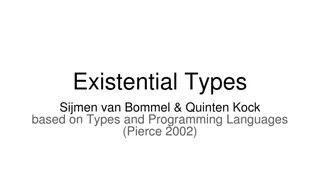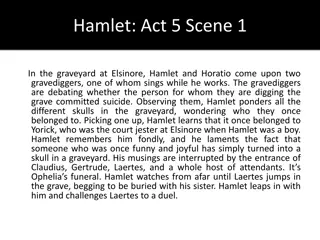Why Simplified Data Manipulation is the Future of BI Dashboard Software
Discover why simplified data manipulation is revolutionizing BI dashboard software. As businesses strive for real-time insights and data-driven decisions, the need for intuitive and efficient BI tools becomes paramount.
1 views • 6 slides
Simplified Data Manipulation and Cleaning Without Coding
To fully experience and leverage the potential of your data, complex coding is not always the best bet. Business users and analysts can increase their productivity by leaving everyday challenges at bay. Our latest blog explores how no-code Business Intelligence tools are revolutionizing data manipul
3 views • 6 slides
Insights into "The Tempest": Power, Manipulation, and Restoration
In Act III of "The Tempest," themes of power, manipulation, and restoration unfold. Ferdinand's labor for Miranda symbolizes love's easing of difficulties. Prospero orchestrates magic and illusion to ensure Miranda and Ferdinand fall in love. Stephano's drunken power play highlights selfish motives
0 views • 13 slides
Intriguing Developments in Shakespeare's "Hamlet" Act Two
Polonius sends a spy to France, Ophelia recounts Hamlet's erratic behavior, and Hamlet plans to expose King Claudius's guilt through a play. Key plot points established include Hamlet's supposed madness due to unrequited love, the arrival of his friends Rosencrantz and Guildenstern, and the actors'
0 views • 4 slides
Analyzing Iago's Manipulation in Othello Act 2 Scene 3
Explore the intricate dynamics between Iago and Cassio in Act 2 Scene 3 of Othello. Dive into the themes of manipulation, loyalty, and deception as Iago orchestrates his plans while examining Cassio's susceptibility to Iago's ploys. Uncover the layers of dramatic irony, thematic contrasts, and chara
0 views • 8 slides
Analysis of Hamlet's Sixth Soliloquy in Act 3, Scene 3
Hamlet's Sixth Soliloquy in Act 3, Scene 3 delves into his inner turmoil as he contemplates seeking revenge on Claudius for his father's murder. Despite having the perfect opportunity to kill Claudius while he prays, Hamlet hesitates, questioning whether sending him to heaven would truly be an act o
0 views • 7 slides
Genetic Engineering: Techniques, Models, and Applications in Microbial Biotechnology and Plant Genetics
This document explores genetic manipulation, gene manipulation techniques, gene transfer techniques, applications in synthetic and developmental biology, genetically modified organisms/plants, plant tissue culture, micropropagation of plants, genetics in evolution, and genetics in crop improvement m
0 views • 5 slides
Hamlet's Second Soliloquy: The Revelation and Vow for Revenge
Hamlet's second soliloquy in Act 1, Scene 5, follows the shocking revelation from his father's ghost that Claudius is the true murderer. Filled with grief and anger, Hamlet vows to avenge his father's death, referring to his mother as a "pernicious woman" and his uncle as a "smiling damned villain."
0 views • 5 slides
How Advanced Data Manipulation Techniques Are Transforming UK Businesses
Gain insight into the ways that cutting-edge data manipulation techniques are reshaping the UK corporate landscape with more improved decision-making, effectiveness in operations, and greater client customisation. With the use of real-world examples
1 views • 9 slides
Exploring EViews Data Functions for Data Manipulation
EViews offers a wide range of built-in functions for data manipulation, including generating random numbers, statistical functions, and time series functions. This tutorial provides examples of how to utilize these functions within EViews to perform various data operations effectively.
0 views • 49 slides
Insights from Critics on Hamlet's Character and Themes
Various critics provide intriguing perspectives on Hamlet's character and the themes within the play. Swinburne emphasizes Hamlet's inner nature as a conflux of forces, while Samuel Johnson views Hamlet more as an instrument than an agent. Von Goethe discusses the challenges faced by Hamlet in fulfi
0 views • 22 slides
Explore Sounds Write Phonics Program in Year 1 Classroom
The Sounds Write phonics program in a Year 1 classroom focuses on teaching essential reading and writing skills like segmenting, blending, and phoneme manipulation. Through engaging learning experiences and daily practice, students develop fluency in reading and writing. The program includes activit
0 views • 17 slides
Genetic Manipulation in Environmental Biotechnology
Genetic manipulation strategies in environmental biotechnology involve techniques like gene splicing and molecular cloning to modify genes directly. These methods have various applications such as isolating genes, producing specific molecules, improving biochemical production, creating organisms wit
0 views • 20 slides
Understanding Maitland Mobilisation and Manipulation Techniques
Maitland Mobilisation involves passive movements performed with rhythm and grades that the patient can control, while Manipulation is a precise localized technique involving quick, small movements. Key concepts include the patient-centered approach and the brick wall approach. Principles emphasize c
0 views • 23 slides
Enhancing Crop Yield and Quality Through Genetic Manipulation
This chapter explores methods to improve crop productivity and quality through genetic enhancements such as increasing yield and improving plant material quality. It discusses factors influencing crop productivity, such as solar radiation and photosynthetic efficiency, and factors determining crop q
0 views • 19 slides
Understanding Ethical Considerations in Manipulated Photography for Media
Ethical control in photojournalism involves capturing non-fiction events without manipulation, but some control over the image is acceptable within ethical bounds. However, moving into manipulated images for non-news events requires a different approach, involving subject and scene manipulation for
0 views • 28 slides
How Advanced Algorithms Are Reshaping Data Manipulation
Explore the transformative impact of advanced algorithms on data manipulation in our latest feature. This insightful exploration delves into the sophisticated technologies revolutionizing business analytics and understanding what is data manipulation
0 views • 7 slides
Analyzing the Impact of Glucose on Students' Listening Span
Research presented by Dr. Christine Malone explores how drinking glucose can enhance listening span in students who miss breakfast. The study investigates if the experiment qualifies as a true experiment by analyzing key features like manipulation, measurement, comparison, and control. Internal vali
1 views • 12 slides
APL - A Functional Language with Array Paradigms
APL, named after the book "A Programming Language Paradigms," is a functional language with a focus on array manipulation. Developed in the 1960s by Kenneth E. Iverson, it has had a significant impact on the development of spreadsheets and computer math packages. APL operates with chains of monadic
0 views • 11 slides
Basin Manipulation Simulation Analysis Tool Overview
Basin Manipulation Simulation Analysis Tool provides a comprehensive solution for managing and analyzing basin data, including tasks like basin manipulation, simulation analysis, case management, and defining simulation time steps. The tool allows for easy data entry, visualization of simulation res
2 views • 17 slides
Tragic Events Unfold in Act IV of "Hamlet
Ophelia, reeling from her father's death, cryptically speaks about flowers, revealing underlying accusations. Laertes, manipulated by Claudius, seeks vengeance impulsively. Hamlet's unseen pirate adventure raises questions. Ophelia's demise in the brook signifies a tragic turn in the play.
2 views • 6 slides
Insights into Animal Farm: A Narrative of Betrayal and Manipulation
The narrative of Animal Farm encapsulates the evolution from an idealistic society to a manipulative regime, illustrating themes of betrayal, rule violations, manipulation, leadership exaggeration, harsh penalties, rumor spreading, forced labor, and emotional suppression within a communist-socialist
0 views • 10 slides
Understanding Strings and Operations in Programming
This content delves into the concepts of strings, their manipulation methods, and various operations related to strings in programming. It covers collection data types, immutable nature of strings, string operations like concatenation and slicing, comparing strings, and practical examples of string
4 views • 29 slides
Understanding Existential Types and Type Manipulation in Programming Languages
Explore the concepts of existential types, type abstraction, type ambiguity, packing, and unpacking in the context of programming languages. Learn how to work with hidden types, universal types, and the nuances of type manipulation. Examples and illustrations are provided to enhance understanding.
0 views • 17 slides
Comparing Apotheosis in Roman Culture: Trimalchio and the Julio-Claudians
Tracing the concept of apotheosis in Roman culture, this content explores the contrasting deification processes of Trimalchio and the Julio-Claudian emperors, focusing on the visual representations and societal perceptions of divinity. From Trimalchio's extravagant depiction to the imperial cult of
0 views • 6 slides
The Skinhead Hamlet - Act 1, Scene 4
In Act 1, Scene 4 of "The Skinhead Hamlet," the Ghost reveals to Hamlet that he was murdered by Claudius, the current king of Denmark. The Ghost urges Hamlet to seek revenge for his untimely death, shedding light on the treachery that led to his demise. This snippet captures the intense and pivotal
0 views • 18 slides
Analysis of Lady Macbeth's Manipulation in Shakespeare's Macbeth
In a pivotal moment in Macbeth, Lady Macbeth's manipulation of her husband is showcased when she calls upon supernatural forces to overcome his kindness and convince him to kill Duncan. This extract is crucial in introducing Lady Macbeth's character and power dynamics within the play, particularly h
0 views • 49 slides
Analysis of Act I Scene IV in Hamlet: Themes and Symbolism
Hamlet waits on the castle battlements for the ghost of the dead king to appear. Despite objections, he follows the ghost, setting a tone of nervous anticipation. The scene contrasts domestic and military settings, emphasizing urgency. The sound of cannon signals excessive drinking and partying at C
0 views • 15 slides
Character Analysis of Hamlet: A Tragic Tale of Revenge and Betrayal
Son of King Hamlet, Hamlet is charged with avenging his father's murder by his uncle, Claudius, in Shakespeare's iconic play. As Hamlet spirals into madness and dark thoughts, he struggles with doubts, guilt, and revenge. Claudius, the cunning antagonist, hides his guilt while plotting against Hamle
0 views • 7 slides
Shakespearean Dramatic Techniques Analysis
Explore the intricate use of monologues, soliloquies, structural divisions, and emotional responses in William Shakespeare's plays. Delve into the dialogues between characters like Hamlet, Gertrude, and Claudius to uncover themes of love, madness, and expectation. Discover how Shakespeare utilizes d
0 views • 23 slides
Storage and Manipulation of Liquefied Gases with Dewars and Cryostats
Storage and manipulation of liquefied gases involve using specialized equipment like Dewars and Cryostats to minimize heat transfer and maintain low temperatures. Dewars, invented by James Dewar, are double-walled vacuum vessels designed to store liquefied gases with minimal losses. The use of vacuu
0 views • 11 slides
Understanding Direct Manipulation in HCI
In this lecture, learn about the concept of direct manipulation in Human-Computer Interaction (HCI), including its benefits, drawbacks, and related terms such as engagement, distance, semantic, and articulatory distances. Explore the evolution of GUIs and interaction styles, and compare edge maps an
0 views • 24 slides
Analysis of Act I, Scene II in Shakespeare's Hamlet
The scene delves into complex themes such as royalty, grief, revenge, and morality, focusing on Hamlet's internal struggles and interactions with other characters. It highlights Hamlet's melancholic nature, his relationships with his mother and deceased father, and introduces key questions surroundi
0 views • 17 slides
Understanding Narcissistic Abuse: The Insidious Manipulation of Victims
Narcissistic abuse is a form of severe psychological and emotional manipulation that targets a victim's spirit and identity. The abuser employs tactics such as lying, manipulation, denial of reality, and control. This abuse is often invisible and devastating, characterized by a lack of empathy and a
0 views • 15 slides
Ethical Analysis of Manipulation in Organ Allocation System
This resource tackles the issue of manipulation in organ transplant waitlist priority through unnecessary medical interventions. It highlights the ethical concerns, potential harms, and ways to mitigate this manipulation, urging adherence to systemic safeguards and ethical clinical practice.
0 views • 9 slides
Ethics of Animal Experimentation in Medical Research
Exploring the application of utilitarianism to animal experimentation for medical research, this content delves into the history of vivisection, animal rights activism, and the work of historical figures like Claudius Galen in advancing medical understanding through dissection. The ethical considera
0 views • 17 slides
Character Analysis of Hamlet in Shakespeare's Play
Explore the character of Hamlet in William Shakespeare's renowned play through comparisons with other characters such as Horatio, Claudius, Fortinbras, and Laertes. Delve into the contrasting qualities, motivations, and actions of Hamlet and these characters to gain a deeper understanding of Hamlet'
0 views • 8 slides
Polonius in Shakespeare's Hamlet: Extended Character Analysis
Polonius, King Claudius's advisor and the father of Ophelia and Laertes in Shakespeare's play "Hamlet," is portrayed as a character concerned with appearances and reputation. His fatherly advice, though well-intentioned, is filled with clichéd aphorisms. As a royal advisor, Polonius engages in unde
0 views • 25 slides
Innovative Multicellular Computing Circuits for Genetic Manipulation
Cells are utilized as computational devices in a innovative approach for genetic manipulation. Various logic gates and promoters are combined to achieve complex circuit behavior without the need for genetic manipulation. Advantages include a wide dynamic range and low variability, but with the drawb
0 views • 10 slides
Tragedy in Elsinore: Hamlet's Final Acts
Hamlet encounters the gravediggers, reflects on life and death in the graveyard, and faces betrayal and tragedy in a series of duels orchestrated by Claudius. As the plot unfolds, there are deaths, poisoned schemes, and Hamlet's own demise, ending with Fortinbras claiming the throne. The major plot
0 views • 5 slides







































